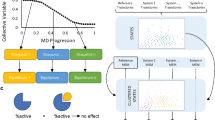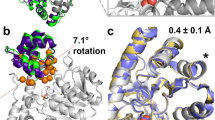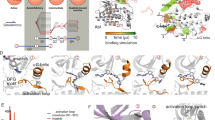Abstract
The ability to inhibit binding or enzymatic activity is key to preventing aberrant behaviors of proteins. Allosteric inhibition is desirable as it offers several advantages over competitive inhibition, but the mechanisms of action remain poorly understood in most cases. Here we show that allosteric inhibition can be effected by destabilizing a low-populated conformational state that serves as an on-pathway intermediate for ligand binding, without altering the protein's ground-state structure. As standard structural approaches are typically concerned with changes in the ground-state structure of proteins, the presence of such a mechanism can go easily undetected. Our data strongly argue for the routine use of NMR tools suited to detect and characterize transiently formed conformational states in allosteric systems. Structure information on such important intermediates can ultimately result in more efficient design of allosteric inhibitors.
This is a preview of subscription content, access via your institution
Access options
Subscribe to this journal
Receive 12 print issues and online access
$259.00 per year
only $21.58 per issue
Buy this article
- Purchase on Springer Link
- Instant access to full article PDF
Prices may be subject to local taxes which are calculated during checkout




Similar content being viewed by others
References
Wells, J.A. & McClendon, C.L. Reaching for high-hanging fruit in drug discovery at protein-protein interfaces. Nature 450, 1001–1009 (2007).
Lee, G.M. & Craik, C.S. Trapping moving targets with small molecules. Science 324, 213–215 (2009).
Hardy, J.A. & Wells, J.A. Searching for new allosteric sites in enzymes. Curr. Opin. Struct. Biol. 14, 706–715 (2004).
Groebe, D.R. In search of negative allosteric modulators of biological targets. Drug Discov. Today 14, 41–49 (2009).
Maksay, G. Allostery in pharmacology: thermodynamics, evolution and design. Prog. Biophys. Mol. Biol. 106, 463–473 (2011).
Arkin, M.R. & Wells, J.A. Small-molecule inhibitors of protein-protein interactions: progressing towards the dream. Nat. Rev. Drug Discov. 3, 301–317 (2004).
Tzeng, S.-R. & Kalodimos, C.G. Protein dynamics and allostery: an NMR view. Curr. Opin. Struct. Biol. 21, 62–67 (2011).
Passner, J.M., Schultz, S. & Steitz, T. Modeling the cAMP-induced allosteric transition using the crystal structure of CAP–cAMP at 2.1 Å resolution. J. Mol. Biol. 304, 847–859 (2000).
Popovych, N., Tzeng, S.-R., Tonelli, M., Ebright, R.H. & Kalodimos, C.G. Structural basis for cAMP-mediated allosteric control of the catabolite activator protein. Proc. Natl. Acad. Sci. USA 106, 6927–6932 (2009).
Gekko, K., Obu, N., Li, J. & Lee, J. A linear correlation between the energetics of allosteric communication and protein flexibility in the Escherichia coli cyclic AMP receptor protein revealed by mutation-induced changes in compressibility and amide hydrogen-deuterium exchange. Biochemistry 43, 3844–3852 (2004).
Youn, H., Koh, J. & Roberts, G. Two-state allosteric modeling suggests protein equilibrium as an integral component for cyclic AMP (cAMP) specificity in the cAMP receptor protein of Escherichia coli. J. Bacteriol. 190, 4532–4540 (2008).
Tzeng, S.-R. & Kalodimos, C.G. Dynamic activation of an allosteric regulatory protein. Nature 462, 368–372 (2009).
Tzeng, S.-R. & Kalodimos, C.G. Protein activity regulation by conformational entropy. Nature 488, 236–240 (2012).
Palmer, A.G., Kroenke, C.D. & Loria, J.P. Nuclear magnetic resonance methods for quantifying microsecond-to-millisecond motions in biological macromolecules. Methods Enzymol. 339, 204–238 (2001).
Baldwin, A.J. & Kay, L.E. NMR spectroscopy brings invisible protein states into focus. Nat. Chem. Biol. 5, 808–814 (2009).
Youn, H., Kerby, R., Conrad, M. & Roberts, G. Study of highly constitutively active mutants suggests how cAMP activates cAMP receptor protein. J. Biol. Chem. 281, 1119–1127 (2006).
Loria, J.P., Rance, M. & Palmer, A.G.A. TROSY CPMG sequence for characterizing chemical exchange in large proteins. J. Biomol. NMR 15, 151–155 (1999).
Korzhnev, D.M., Kloiber, K., Kanelis, V., Tugarinov, V. & Kay, L.E. Probing slow dynamics in high molecular weight proteins by methyl-TROSY NMR spectroscopy: application to a 723-residue enzyme. J. Am. Chem. Soc. 126, 3964–3973 (2004).
Bouvignies, G. et al. Solution structure of a minor and transiently formed state of a T4 lysozyme mutant. Nature 477, 111–114 (2011).
Boehr, D.D., McElheny, D., Dyson, H. & Wright, P. The dynamic energy landscape of dihydrofolate reductase catalysis. Science 313, 1638–1642 (2006).
Carroll, M.J. et al. Evidence for dynamics in proteins as a mechanism for ligand dissociation. Nat. Chem. Biol. 8, 246–252 (2012).
Masterson, L.R. et al. cAMP-dependent protein kinase A selects the excited state of the membrane substrate phospholamban. J. Mol. Biol. 412, 155–164 (2011).
Lipchock, J.M. & Loria, J.P. Nanometer propagation of millisecond motions in V-type allostery. Structure 18, 1596–1607 (2010).
Neudecker, P. et al. Structure of an intermediate state in protein folding and aggregation. Science 336, 362–366 (2012).
Vendruscolo, M. Excited-state control of protein activity. J. Mol. Biol. 412, 153–154 (2011).
Boehr, D.D., Nussinov, R. & Wright, P.E. The role of dynamic conformational ensembles in biomolecular recognition. Nat. Chem. Biol. 5, 789–796 (2009).
Chen, L. et al. Structural instability tuning as a regulatory mechanism in protein-protein interactions. Mol. Cell 44, 734–744 (2011).
Sprangers, R. & Kay, L.E. Quantitative dynamics and binding studies of the 20S proteasome by NMR. Nature 445, 618–622 (2007).
Gelis, I. et al. Structural basis for signal-sequence recognition by the translocase motor SecA as determined by NMR. Cell 131, 756–769 (2007).
Takeuchi, K., Ng, E., Malia, T.J. & Wagner, G. 1-13C amino acid selective labeling in a 2H15N background for NMR studies of large proteins. J. Biomol. NMR 38, 89–98 (2007).
Evenäs, J. et al. Ligand-induced structural changes to maltodextrin-binding protein as studied by solution NMR spectroscopy. J. Mol. Biol. 309, 961–974 (2001).
Mandel, A.M., Akke, M. & Palmer, A. Backbone dynamics of Escherichia coli ribonuclease HI: correlations with structure and function in an active enzyme. J. Mol. Biol. 246, 144–163 (1995).
Cole, R. & Loria, J. FAST-Modelfree: a program for rapid automated analysis of solution NMR spin-relaxation data. J. Biomol. NMR 26, 203–213 (2003).
d'Auvergne, E.J. & Gooley, P. Optimisation of NMR dynamic models I. Minimisation algorithms and their performance within the model-free and Brownian rotational diffusion spaces. J. Biomol. NMR 40, 107–119 (2008).
Lipari, G. & Szabo, A. Model-free approach to the interpretation of nuclear magnetic resonance relaxation in macromolecules. 1. Theory and range of validity. J. Am. Chem. Soc. 104, 4546–4559 (1982).
Tjandra, N., Feller, S., Pastor, R. & Bax, A. Rotational diffusion anisotropy of human ubiquitin from N-15 NMR relaxation. J. Am. Chem. Soc. 117, 12562–12566 (1995).
Hwang, P.M., Skrynnikov, N. & Kay, L. Domain orientation in beta-cyclodextrin-loaded maltose binding protein: diffusion anisotropy measurements confirm the results of a dipolar coupling study. J. Biomol. NMR 20, 83–88 (2001).
Dosset, P., Hus, J., Blackledge, M. & Marion, D. Efficient analysis of macromolecular rotational diffusion from heteronuclear relaxation data. J. Biomol. NMR 16, 23–28 (2000).
Mulder, F.A., Mittermaier, A., Hon, B., Dahlquist, F. & Kay, L. Studying excited states of proteins by NMR spectroscopy. Nat. Struct. Biol. 8, 932–935 (2001).
Carver, J.P. & Richards, R.E. A general two-site solution for the chemical exchange produced dependence of T2 upon the Carr-Purcell pulse separation. J. Magn. Reson. 6, 89–105 (1972).
Watt, E.D., Shimada, H., Kovrigin, E. & Loria, J. The mechanism of rate-limiting motions in enzyme function. Proc. Natl. Acad. Sci. USA 104, 11981–11986 (2007).
Henzler-Wildman, K.A. et al. Intrinsic motions along an enzymatic reaction trajectory. Nature 450, 838–844 (2007).
Korzhnev, D.M. et al. Low-populated folding intermediates of Fyn SH3 characterized by relaxation dispersion NMR. Nature 430, 586–590 (2004).
Millet, O., Loria, J., Kroenke, C., Pons, M. & Palmer, A. The static magnetic field dependence of chemical exchange linebroadening defines the NMR chemical shift time scale. J. Am. Chem. Soc. 122, 2867–2877 (2000).
Shen, Y., Delaglio, F., Cornilescu, G. & Bax, A. TALOS+: a hybrid method for predicting protein backbone torsion angles from NMR chemical shifts. J. Biomol. NMR 44, 213–223 (2009).
Acknowledgements
This work was supported by the US National Science Foundation grant MCB1121896 to C.G.K.
Author information
Authors and Affiliations
Contributions
S.-R.T. and C.G.K. conceived the project. S.-R.T. and C.G.K. designed the experiments. S.-R.T. performed all of the experiments. S.-R.T. and C.G.K. analyzed and interpreted the data and wrote the manuscript.
Corresponding author
Ethics declarations
Competing interests
The authors declare no competing financial interests.
Supplementary information
Supplementary Text and Figures
Supplementary Results (PDF 822 kb)
Rights and permissions
About this article
Cite this article
Tzeng, SR., Kalodimos, C. Allosteric inhibition through suppression of transient conformational states. Nat Chem Biol 9, 462–465 (2013). https://doi.org/10.1038/nchembio.1250
Received:
Accepted:
Published:
Issue Date:
DOI: https://doi.org/10.1038/nchembio.1250
This article is cited by
-
Advances of Predicting Allosteric Mechanisms Through Protein Contact in New Technologies and Their Application
Molecular Biotechnology (2023)
-
cAMP Activation of the cAMP Receptor Protein, a Model Bacterial Transcription Factor
Journal of Microbiology (2023)
-
Molecular basis for the allosteric activation mechanism of the heterodimeric imidazole glycerol phosphate synthase complex
Nature Communications (2021)
-
Structural basis for cross-reactivity and conformation fluctuation of the major beech pollen allergen Fag s 1
Scientific Reports (2018)
-
Allosteric inhibition of aminopeptidase N functions related to tumor growth and virus infection
Scientific Reports (2017)



